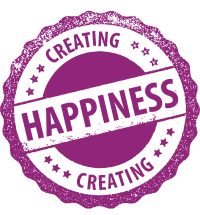Cognitive defusion is a therapeutic tool, introduced by Acceptance and Commitment Therapy (ACT), a scientifically based cognitive behavioural approach. Those who have worked with me know that I love it and think it should be taught at every elementary school, which would alleviate a ton of mental and emotional suffering.
In order to have a good quality of life, you need to have healthy thinking patterns and understand that a thought and thinking are two different things, and that your brain does not come up with truth, but an array of random stories.
Many of us accept any story (aka thoughts, I will use both terms interchangeably) that our brain comes up with as truth, hook into it, and start an internal dialogue with it. This can lead to a lot of misery. For example, if a self-defeating story like, “I am not good enough”, or, “I am stupid” pops up, understand that this is not the truth, it is just a story. Most likely one that somebody told you a long time ago and that you have internalized by now.
Our brain cannot tolerate a vacuum, and it will always come up with new thoughts. It comes up with all kinds of stories trying to make sense of the world. Some of them are useful, others not so much. Your job is to teach your brain which stories work for you, and which stories don’t. You can teach your brain by only responding to productive thoughts, and letting unproductive thoughts come and go without hooking into them. This is where cognitive defusion comes in, it is an effective mental health tool that will allow you to become a proactive thinker and start leading your brain instead of being led by it.
Ready? Let’s roll. The following steps will teach you about cognitive defusion and how to apply it to your life.
1. Treat your mind like an external event, almost like a separate person.
Say something like, “Well, there goes my mind again worrying”, or, “There goes my mind again putting me down”.
Learning to become a neutral, compassionate observer of your thinking will allow you to take a step back, and realize that you are not your thoughts, but that there is a part of you that can observe your thoughts. This can help you gain some distance and perspective.
Welcome all thoughts, don’t judge them, don’t pose any resistance, knowing that there are no good or bad thoughts, all of them are ok. There are no dangerous thoughts, none of them can harm you.
2. Label your thoughts as thoughts.
How is it different if you label a thought? For example, if your thought is, “I am unacceptable”. How is it different to tell yourself, “I am unacceptable”, versus labeling your thought as thought and telling yourself, “I am having the thought that I am acceptable”?
One of them feels like truth, the other acknowledges that your thought is just a story your brain has come up with.
This is another way of taking a step back and seeing the thought for what it is, an automatic brain reflex, saying nothing about who you are.
3. Thank your mind when it comes up with worries and judgments.
You could say something like, “Thank you mind, you’re doing a great job of worrying today”. This is not sarcasm. From an evolutionary perspective, your mind is doing exactly what it is supposed to do, scan for danger and assure your survival.
However, your brain has difficulty differentiating between reality and fantasy. If you worry a lot and imagine bad things happening to you, your brain is going to believe you, and a flight or fight response will be triggered, which then will lead to anxiety symptoms.
Your job is to let your brain know that your anxiety thoughts are not true, they are just fear fantasies, so your brain can again return to a relaxed state.
4. Imagine your thoughts like clouds floating across the sky.
You can just notice them, letting them pass by, without hooking into them. Or, you can imagine your thoughts like leaves floating down a stream. You don’t have to dive in to get them. You can watch them from the bridge, slowly disappearing in the distance. Another option is to imagine them like pop-ads on your computer screen, coming and going.
Find a visual that works for you and use it when learning to let thoughts come and go. My favourite way of imagining my thoughts is to visualize them as clouds. I picture my toxic thoughts as big, ominous hail clouds and less loaded thoughts as small, white, and fluffy ones. All of them coming and going, while lying on the grass and watching them pass by.
5. Don’t hook into your thoughts.
Cognitive defusion teaches you to not hook into an unproductive thought, and as you let the thought pass by, it has no choice but to soften and fade away. Each thought, if not reinforced, is finite.
By refraining from starting a dialogue with it, you won’t reinforce that toxic thought, which then is less likely to appear again. This way, you are rewiring your brain, teaching it to find new default thoughts. Over time, with consistency and perseverance, your default can be to have productive and positive thinking patterns.
6. Welcome all of your thoughts, they are all ok.
Welcome all thoughts, don’t judge them or fight them. There are no good or bad thoughts, all of them are ok. There are no dangerous thoughts, none of them can harm you. Thoughts are simply automatic brain reflexes, random stories your brain comes up with.
If you judge a thought, or try not to think it, it will actually have the opposite effect you are hoping for, the thought will pop up more frequently and stick around longer.
Have you ever heard of the psychological white bear experiment? It is an experiment that has shown that deliberate attempts to suppress certain thoughts make them more likely to surface. The participants were asked to actively not think of a white bear. Well, how do you think that went? Right, the more you don’t want to think of a white bear, the more your brain is coming up with “white bear thoughts”.
7. Find the pause after the first thought.
The following quote is frequently attributed to Victor Frankl, an Austrian psychologist who is the founder of logotherapy, “Between stimulus and response there is a space, and in that space lies our growth and our freedom.” This quote summarizes the teachings of cognitive defusion eloquently.
Your first thought is the stimulus and before you allow yourself to automatically hook into that thought, look for space between the stimulus and your response. You can use that space to make a conscious decision and decide if this is a useful thought and if it is beneficial to have a dialogue with, or if it is better to let the thought pass by.
Cognitive defusion is a skill that needs to be practiced, just like you would need to practice a new dance routine. Neuroplasticity, the process of changing the way your brain thinks, requires your consistency and perseverance.
However, if you give this new way of thinking a solid effort for the next 30 consecutive days, applying it on a daily basis, I feel confident that you will see a significant difference and your mental health will thank you.

This post is part of the blog series "Creating Happiness", your inspiration to promote positive change in your life.
Do you like Daniela's posts? Subscribe to her blog series:
ABOUT THE AUTHOR
Ms Daniela Beer-Becker, Psychologist
Daniela is a regular contributor to the Blake Psychology blog and author of the "Creating Happiness" series.
MORE POSTS IN THE SERIES
















